Dinosaur Valley State Park near Glenn Rose, Texas is widely known for dinosaur tracks exposed by the erosion of the Paluxy river. The most famous (or infamous) of these tracks are unusually long impressions that when sufficiently eroded superficially resemble giant human footprints. Unfortunately, this led to a number of sensational claims including some carved fakes. In 1975, a creationist team from Loma Linda university investigated the site and upon close scientific examination found evidence of only dinosaur causation(1). In the years since it has generally been accepted by both creation and secular scientists that both the long and more typical short footprints are both from dinosaurs(2, 3).
However, just because the long tracks are not human footprints doesn’t mean these tracks aren’t of great interest to creation science. The long impressions come from what is called the “metatarsal” bones(4). If you haven’t had an anatomy class lately don’t let the terminology scare you. The metatarsals are a fairly long set of bones located just above the toe area. For example, in our human feet the metatarsals are located in the area of #4 below.
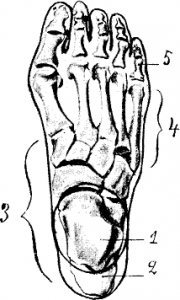
Because God created humans with a vertical posture he gave us relatively long and narrow feet to stabilize our bodies. Stating the obvious this means when we stand our metatarsals are nearly parallel with the ground. In many kinds of animals this is not the case. In dogs and cats the metatarsals are relatively vertical and behave as an extension of the leg. The only part of the foot that a cat or dog stands on is the toe area. (i.e. the “paws”)
What makes the Paluxy tracks so challenging is that without these tracks we could be fairly dogmatic that dinosaurs were also designed by God to walk on their toes. The vase majority of dinosaur tracks at other sites feature toe only impressions. (However, we must take this evidence cautiously. Since the footprints were laid down during the flood year a “toes only” footprint may be a response to an abnormal environment. Perhaps it’s a swimming (think of bouncing on your toes in a swimming pool) or a running posture.) A more convincing piece of evidence comes from the bones themselves. Some kinds of dinosaurs certainly had more flexibility and range of motion than others, but overall the dinosaur foot and leg design appears to be crafted specifically for toe walking. For example: (The metatarsals are located between the two red lines.)
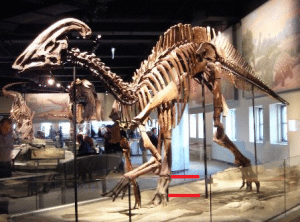
The conundrum presented by the Paluxy tracks is why would we find metatarsal imprints if that is not how dinosaurs were designed to walk? One suggestion is the soil was soft(5) and the dinosaur purposely lowered the bottom portion of the leg to distribute weight across more surface area. This would be similar to how snowshoes are used to walk across soft snow. Photos of the tracks indicate the the soil was soft enough at the time the tracks were created to leave impressions several inches deep. So it is possible the long footprints are a response to the soft water soaked flood soil. However, the photos also show the long footprints are relatively parallel with the surface. There is some slant downwards towards the toes and there is evidence that the deepest parts of the footprints were partially filled with mud in ancient times (5). However, they aren’t as slanted as I would expect in an animal crossing a boggy surface. It seems unlikely that an animal would relax it’s lower legs so completely without trying to dig it’s toes as it struggled to find solid ground. That would have left heavily slanted footprints tiling downwards towards the toes. The lack of that slant suggests the animals didn’t even try to rise up on their toes.
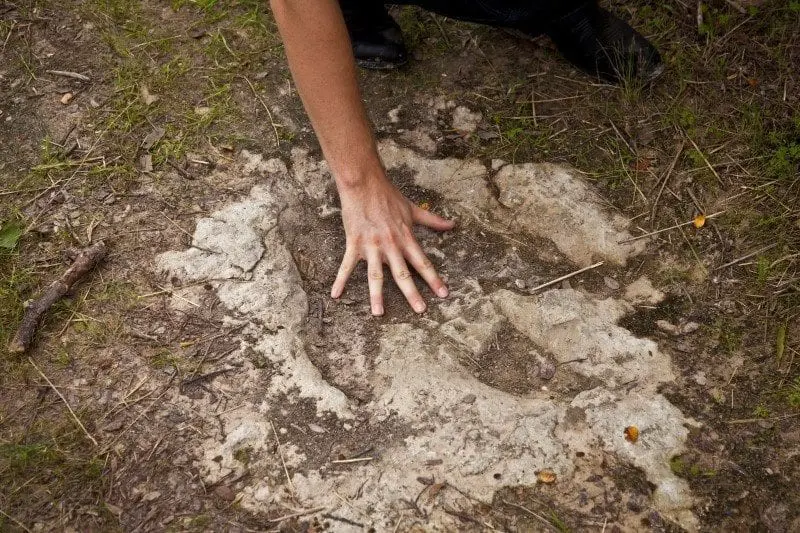
For several years I’ve periodically wondered why these tracks would exhibit such a flat profile and never had a particularly satisfying answer. However, just recently something happened in my very own home that I believe explains what happened.
My beloved, but aging pet cat stopped eating and drinking and became very lethargic. After taking her to the vet I learned she had advanced kidney disease. They gave her extensive injections of fluid and thanks to the excellent veterinary care she perked up and is still living. However, for several days after the injections started she was extremely weak. (Unfortunately her long term prognosis is not good.)
Normally, the hind legs of a cat appear like the the illustration to the left. The green arrow points at the metatarsals(6).
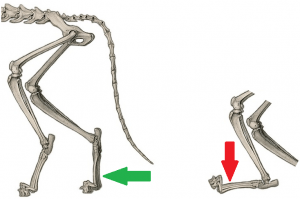
However, in her weak state my cat started walking on her metatarsals (red arrow–rough approximation for illustration only). As I observed it was clear the energy required to walk a set distance with the metatarsals parallel to the ground was higher than normal. However, the flow of energy required at any given moment was much lower. My cat had so completely exhausted it’s energy stores she didn’t have enough energy flow to walk normally. She did however have enough energy flow to shuffle forward on her metatarsal bones. My cat concluded that slow movement was better than no movement.
The skeleton of a cat is very different from that of a dinosaur. But there is at least a superficial similarity in the arrangement of the metatarsals. Here’s another example of the metatarsal portion of a dinosaur leg. (The area between the red lines)
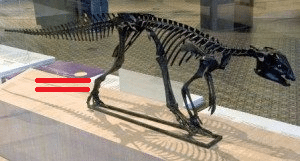
Is it possible that under low energy conditions certain dinosaurs may loose the ability to hold up the metatarsals like my cat did? I don’t know. It may not be knowable. Generalizing the behavior of one animal into another is always a risky bet. But, it does seem possible that by the time the Paluxy tracks were made the dinosaurs could have been fighting for survival against the flood for an extended length of time. Water would have been freely available so the animals were probably well hydrated (similar to my cat after the injections), but would have experienced extensive energy burn with little or no nourishment to make up for loss. Could these long tracks be physical evidence that the animals had weakened to the point they no longer hold up their body weight?
I like to imagine them head down, backs turned against the storm, plodding step by step in a desperate search to escape their doomed world.
———————
I welcome any additional research on the topic. I believe one of the greatest advantages of creation scientist is that we have the scriptures that lay out the context of what happened. Then we get to have the fun of trying to figure out the details!
1) Neufeld, Berney, 1975, Dinosaur Tracks and Giant Men. Origins , Vol. 2, No. 2, pp. 64-76 (http://www.grisda.org/origins/02064.htm)
2) Emil Silvestru, Human and dinosaur fossil footprints in the Upper Cretaceous of North America?, (https://creation.com/human-and-dinosaur-fossil-footprints)
3) J. O. Farlow, et al, Dinosaur Tracksites of the Paluxy River Valley (Glen Rose Formation, Lower Cretaceous), Dinosaur Valley State Park, Somervell County, Texas, http://paleo.cc/paluxy/Farlow%20et%20al%202012%20Paluxy%20River%20tracksites.pdf
4) Glen J. Kuban, Origins Research, Vol. 9, No. 1, Spring/Summer 1986, pp. 2-10. (http://paleo.cc/paluxy/tsite.htm)
5) Glen J. Kuban, On the Heels of Dinosaurs: An Informal “History of the Texas “Man Track” Controversy. (http://paleo.cc/paluxy/onheel.htm)
6) Wild cat skeleton, but very similar to domesticated cats: (https://commons.wikimedia.org/wiki/File:Felis_silvestris_restoration_%26_skeleton.jpg)

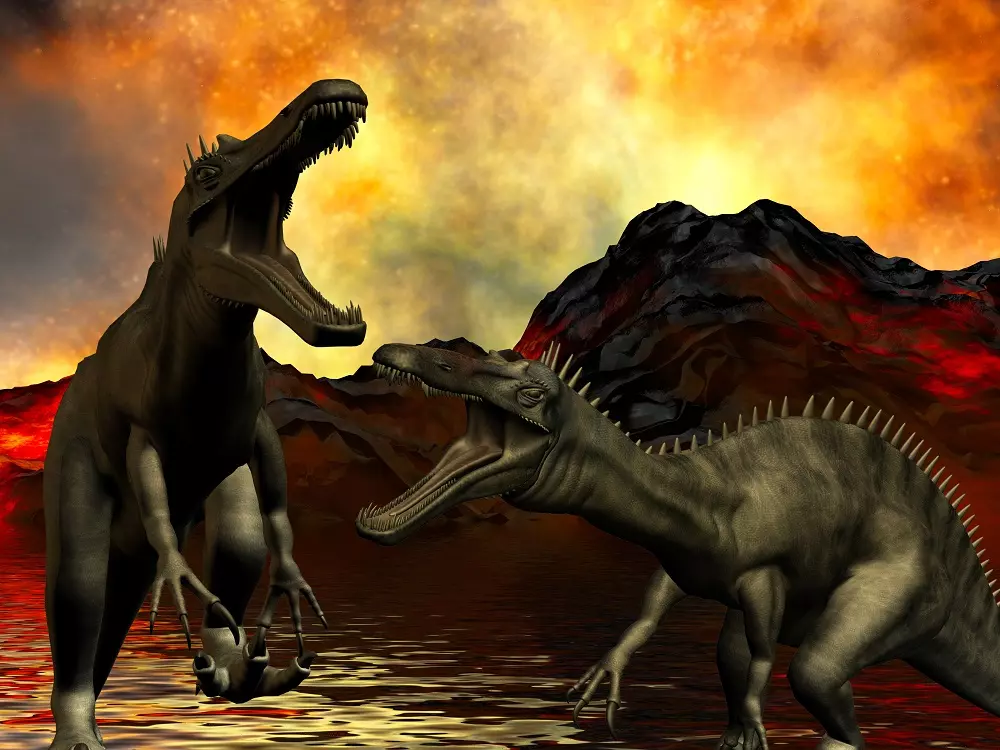






Glad to see your interest. Your position is that of Glenn Kuban, whom I’ve spoken to about this. The problem with the tired dinosaur theory is that there are Acrocanthosaurus, T-rex, Megalosaurus and other theropod tracks all over the world just like those at Glen Rose. In fact, there are many more just like them all over Texas and even up to Colorado.Look at the anatomy of a theropod foot; they would practically have to be sitting to make an impression with their heel bones. I have molded the entire Taylor Trail – with the alleged human in dinosaur tracks – and many other tracks from Glen Rose and other places if you ever want to examine them.
Interesting. Do you have any closeup photos of the footprints?
Dear Jeff Staddon,
Thoroughly intrigued by your suggestion in your recent Creation Club article ‘DO LONG FOOTPRINTS IN PALUXY RIVER DINOSAUR TRACKWAYS DEMONSTRATE FALLING ENERGY IN SURVIVING DINOSAURS?’ (sorry, no emotion meant, simply copied the title!:) While I appreciate your not leaping to conclusions, I would think your idea is valid. I lived with my sister for awhile, and just prior to being put down, her golden lab (Sitka, of happiest memory!) was so weak, she began what I took to be crawling on her stomach to get around. But this could also be construed as walking on her metatarsals. I have to think that the huge muscle mass in the hind legs of cats, dogs, and dinosaurs (not to mention humans), would make the energy demands large as well, being the largest muscle group in the body (taken together). So, now you have two examples (possibly).
Sincerely,
John Canfield, Armchair Creationist Curmudgeon
john.canfield15@yahoo.com
Thanks John. That’s really interesting. Thanks for sharing.
The Paluxy river footprints are, beyond the shadow of a doubt, human.
Why not believe observed facts rather than Evolutionary reactions.
Would you mind sharing some references with the group? I’m interested in in the evidence since from what I’ve read (which includes creationists) the evidence is pretty solid that these tracks have three toes.